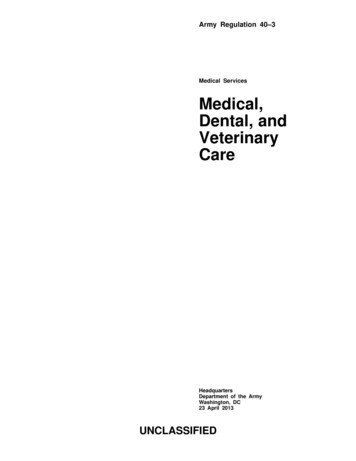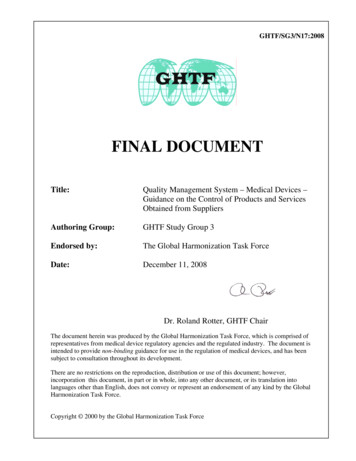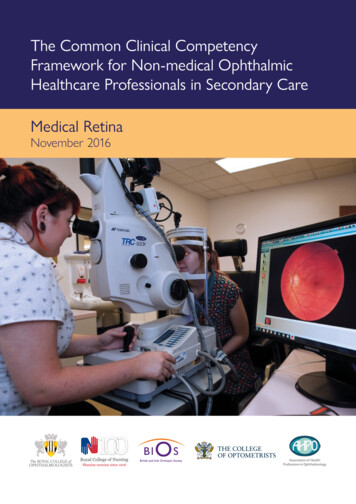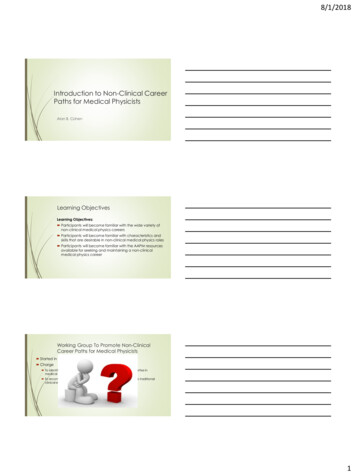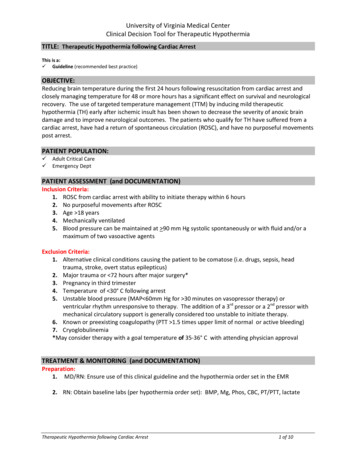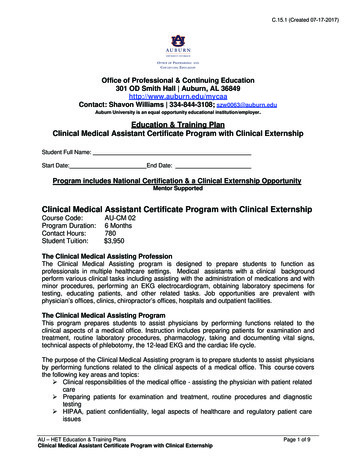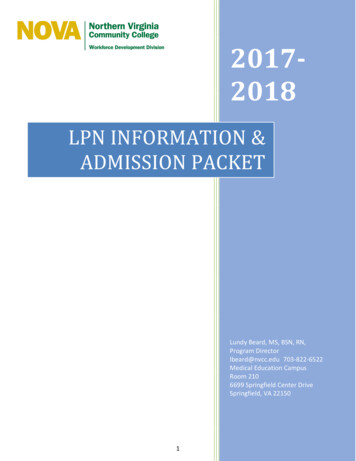
Transcription
Army Regulation 40–68Medical ServicesClinical QualityManagementRapid Action Revision (RAR) Issue Date: 22 May 2009HeadquartersDepartment of the ArmyWashington, DC26 February 2004UNCLASSIFIED
SUMMARY of CHANGEAR 40–68Clinical Quality ManagementThis rapid action revision, dated 22 May 2009-o Establishes specific responsibilities for credentialing functions by ArmyReserve Clinical Credentialing Affairs, Human Resources Command-St.Louis,and Active Army units (para 1-4h).oReplaces all content in chapter 2 with new guidance regarding the ExecutiveCommittee of the Medical Staff; medical staff bylaws; military treatmentfacility committees and functions; and departmental/service organization,structure, and leadership (chap 2).oEliminates the requirement to submit the annual military treatment facilityQuality Management Program Summary Report to the U.S. Army Medical Command(previously covered in chap 2).oIdentifies the American Nurses Association Standards of Nursing Practice orother national professional organizations’ standards as the source ofpractice expectations (para 3-3b(7)).oRelocates information regarding confidentiality of quality assurancedocuments from paragraph 2-5 to chapter 3 (para 3-7).o Requires veterinarians to maintain a current, active, valid, and unrestrictedlicense to practice independently within their defined scope of practice(para 4-4a(1)).oSpecifies the educational preparation by an accredited institution formilitary and civilian registered nurses and licensed practical nurses andrequires the National Council Licensure Examination- Registered Nurses/Practical Nurses for the military Army Nurse Corps and 68WM6/M3 (para 4-6c).oRestates the requirement for an unrestricted license (all Corps) and explainsthe process for limited waiver/exception (paras 4-6g and 4-7).oClarifies the licensure requirement for personal services versus nonpersonal services contract healthcare personnel (para 4-8a).oSpecifies the use of DA Forms 7653 and 7654 for competency verification ofArmy Nurses Corps personnel with skill identifier 8A (Critical Care) and M5(Emergency Nursing) (para 5-1a(1)(b)).oRequires currency of emergency life support training at all times (para 51e).oDeletes the requirement for the advanced practice registered nurse, otherthan the non-personal services advanced practice registered nurse, to possessand maintain advanced practice licensure (para 7-4b(2)).
oRestates the collaborative interaction required between the certifiedregistered nurse anesthetist and anesthesiologist or operating surgeon (para7-4e(4)(a)-(c)).oAuthorizes selected prescription writing by occupational therapists (para 713c(2)(a)(6)).o Updates professional credentials requirements for physician assistants (para7-16b).oClarifies Category I and II privileges for physical therapists (para 7-17c).oProvides 10 USC 1102 protection to all documents in the provider credentialfile and the provider activity file (paras 8-3b(2)(c) and 8-9a).oStipulates that the chairperson of the credentials committee will be aphysician and that he/she will vote only in event of a tie (paras 8-5b and 85c(5).oIndicates that the responsibility for credentials verification forcontracted personnel will be specified in the contract (para 8-6d).oAllows use of the American Board of Medical Specialties Web site to verifyboard certification (para 8-7d).oExempts providers outside the continental United States from the requirementof a current Drug Enforcement Agency certificate (para 8-7k).oDirects that qualified healthcare providers obtain a National ProviderIdentifier (para 8-7r).oProvides detailed information related to telemedicine procedures (para 92c(7)(a)).o Directs the military treatment facility credentials office to maintain theprovider credential file for any assigned provider not currently involved inclinical practice (para 9-6b).o Provides new instruction for U.S. Army Reserve/Army National Guard deploymentprivileging (para 9-8c(4)(d)).oClarifies that peer review for an adverse privileging/practice action beperformed by a panel (para 10-6e(2)(c)).oRequires that a physician chair the adverse actions hearing board (para 108a) and that he/she will vote only in the event of a tie (para 10-8g).oEliminates the requirement for verbatim transcript of the adverse actionshearing board (para 10-8e(3)).oStates that the voluntary modification of privileges/practice as a result ofa medical or behavioral condition is not an adverse privileging/practiceaction (para 11-4c).
oRevises the risk management content entirety and omits reference to the nowdisbanded Consultation Case Review Branch (paras 13-1 through 13-5).oSpecifies that any death/disability of a military member as a result ofmedical care will be treated as a potentially compensable event (para 13-5b).oRevises the layout and contents of the competency assessment file (app C).oMake additional rapid action revision changes (chaps 6, 7, 8, 9, 10, 11,13,14, and apps E, F, G, H, I, J).
*Army Regulation 40–68HeadquartersDepartment of the ArmyWashington, DC26 February 2004Effective 26 March 2004Medical ServicesClinical Quality Managementorganization and equipment environments.It applies to all personnel (Active Army,Army National Guard of the UnitedStates, the U.S. Army Reserve, civilianemployees, contract personnel, and foreign national local hires) who work withinmedical department activities, medicalcenters, dental activities, and organizations for which the Army Medical Department is the responsible official. Thispublication is applicable duringmobilization.History. This publication is a rapid actionrevision (RAR). This RAR is effective 29June 2009. The portions affected by thisRAR are listed in the summary of change.Summary. This consolidated regulationprescribes policies, procedures, and responsibilities for the administration of theClinical Quality Management Program. Itincludes DOD and statutory policies addressing medical services quality management requirements. In addition, itimplements DOD 6025.13–R, DODD6000.14, and other DOD guidance.Applicability. This regulation applies tothe Active Army, the Army NationalGuard of the United States, including periods when operating in an Army NationalGuard capacity, and U.S. Army Reserve.This document applies in both the table ofdistribution and allowances and table ofContentsProponent and exception authority.The proponent of this regulation is TheSurgeon General. The proponent has theauthority to approve exceptions or waiversto this regulation that are consistent withcontrolling law and regulations. The proponent may delegate this approval authority, in writing, to a division chief withinthe proponent agency or a direct reportingunit or field operating agency, in thegrade of colonel or the civilian equivalent.Activities may request a waiver to thisregulation by providing justification thatincludes a full analysis of the expectedbenefits and must include formal reviewby the activity’s senior legal officer. Allwaiver requests will be endorsed by thecommander or senior leader of the requesting activity and forwarded throughtheir higher headquarters to the policyproponent. Refer to AR 25–30 for specificguidance.This regulation contains management control provisions and identifies key management controls that must be evaluated. (Seeappendix J.)Supplementation. Supplementation ofthis regulation and establishment of command and local forms are prohibited without prior approval from The SurgeonGeneral (DASG–HSZ), 5109 LeesburgPike, Falls Church, VA 22041–3258.Suggested improvements. Users areinvited to send comments and suggestedimprovements on DA Form 2028 (Recommended Changes to Publications andBlank Forms) directly to Office of TheSurgeon General (DASG–HSZ), 5109Leesburg Pike, Falls Church, VA22041–3258.Distribution. This publication is available in electronic media only and is intended for command levels B, C, D, andE for the Active Army; C, D, and E forthe Army National Guard of the UnitedStates; and B, C, D, and E for the U. S.Army Reserve.Army management control process.(Listed by paragraph and page number)Chapter 1Introduction, page 1Purpose 1–1, page 1References 1–2, page 1Explanation of abbreviations and terms 1–3, page 1*This regulation supersedes AR 40–68, dated 26 February 2004. This regulation supersedes Army Regulation 40–68, dated 20 December 1989, andArmy Regulation 40–48, dated 7 November 2000. It rescinds DA Forms 5440–17–R, 5440–27–R, and 5441–27–R, dated June 1991; and DA Forms5440–26–1–R, 5440–26–2–R 5441–17–R, 5441–26–1–R, 5441–26–2–R, and 5753–R, dated July 1989. (DA Forms 5440–26–3–R and 5441–26–3–Rwere rescinded in June 1995.) This edition publishes a rapid action revision.AR 40–68 26 February 2004/RAR 22 May 2009UNCLASSIFIEDi
Contents—ContinuedResponsibilities 1–4, page 1Chapter 2Medical Staff and Military Treatment Facility Committee Structure and Functions, page 6General 2–1, page 6Medical staff bylaws 2–2, page 7Military treatment facility departmental structure and leadership 2–3, page 7Executive committee of the medical staff 2–4, page 7Medical staff participation in performance improvement activities 2–5, page 8Other military treatment facility organizational functions and committees 2–6, page 8Chapter 3The Clinical Quality Management Program and Organizational Performance Improvement, page 9The Clinical Quality Management Program 3–1, page 9Processes and functions requiring measurement 3–2, page 9Performance improvement data sources and analyses 3–3, page 9Performance improvement activities in the facility’s written plan 3–4, page 10Facility accreditation 3–5, page 10Patient rights and responsibilities 3–6, page 11Confidentiality of quality assurance documents and records 3–7, page 11Chapter 4Licensure, Certification, and/or Registration of Health Care Professionals, page 11Policy 4–1, page 11Scope of licensure requirement 4–2, page 11Basic licensure, certification, registration criteria 4–3, page 12Professional disciplines requiring license, certification, and/or registration 4–4, page 12Professional responsibility regarding licensure 4–5, page 13Guidance on licensure requirements 4–6, page 14Exceptions to the requirement for unrestricted license 4–7, page 15Contract privileged providers 4–8, page 15International health care graduates 4–9, page 16Failure to obtain or maintain a license, certification, and/or registration 4–10, page 16Chapter 5Competency Assessment, Delegation, and Supervision of Practice, page 17Competency assessment 5–1, page 17Delegation 5–2, page 21Supervision of practice 5–3, page 21Chapter 6The Peer Review Process, page 24General 6–1, page 24The peer review function 6–2, page 24Composition of peer review board 6–3, page 24The intent of peer review 6–4, page 24Conducting the peer review 6–5, page 25Recommendations and followup reporting 6–6, page 25Chapter 7Privileged Health Care Providers, page 25General 7–1, page 25Clinical practice 7–2, page 26Clinical performance review 7–3, page 27Advanced practice registered nurse 7–4, page 27Audiologist 7–5, page 30iiAR 40–68 26 February 2004
Contents—ContinuedBehavioral health practitioner 7–6, page 30Chiropractor 7–7, page 31Clinical pharmacist 7–8, page 32Clinical psychologist 7–9, page 33Clinical social worker 7–10, page 34Dentist 7–11, page 35Dietitian 7–12, page 35Occupational therapist 7–13, page 36Optometrist 7–14, page 37Physician 7–15, page 38Physician assistant and specialty physician assistant 7–16, page 38Physical therapist 7–17, page 42Podiatrist 7–18, page 43Psychological associate 7–19, page 43Speech pathologist 7–20, page 44Chapter 8Credentials Review, page 45General 8–1, page 45Credentials authentication for military accessions 8–2, page 45Military treatment facility authentication of professional credentials 8–3, page 46Privileged provider credentialing 8–4, page 47Military treatment facility credentials committee/function 8–5, page 47Provider credentials verification 8–6, page 49Provider credentials file 8–7, page 50Previous experience and reference checks 8–8, page 52Provider activity file 8–9, page 52The inter-facility credentials transfer brief 8–10, page 53The inter-facility credentials transfer brief and USAR/ARNG training 8–11, page 53USAR/ARNG credentials and privileging for activation/mobilization 8–12, page 54Chapter 9The Privileging Process and Medical Staff Appointment, page 55General 9–1, page 55Practitioners who may be privileged 9–2, page 56Categories of clinical privileges 9–3, page 58The clinical privileging process 9–4, page 59Medical/dental staff appointment 9–5, page 65Provider privileging for temporary duty and other actions involving the provider credentials file 9–6, page 67Separation of privileged providers 9–7, page 67USAR/ARNG privileging procedures 9–8, page 68Chapter 10Adverse Clinical Privileging/Practice Actions, page 71General 10–1, page 71Command responsibility 10–2, page 71Consultation and coordination regarding adverse privileging/practice actions 10–3, page 72Appropriate use of adverse privileging/practice actions 10–4, page 72Other considerations related to adverse privileging/practice actions 10–5, page 73Invoking an adverse privileging/practice action 10–6, page 74Provider hearing rights 10–7, page 78Hearing board procedures 10–8, page 78Action on hearing recommendations 10–9, page 80The appeals process 10–10, page 80Civilian training 10–11, page 81AR 40–68 26 February 2004iii
Contents—ContinuedSeparation from Federal service 10–12, page 81Separation of a criminally charged provider 10–13, page 82Reporting adverse privileging/practice action activities 10–14, page 82Reportable acts of unprofessional conduct 10–15, page 83USAR/ARNG provider/professional adverse privileging/practice actions 10–16, page 83Chapter 11Managing Military Treatment Facility Personnel with Impairments, page 94General 11–1, page 94The Impaired Healthcare Personnel Program 11–2, page 94The composition, role, and function of the impaired healthcare personnel ad hoc committee 11–3, page 95Management of healthcare personnel impaired by medical, psychiatric, or emotional problems 11–4, page 96Management of healthcare personnel impaired by alcohol/other drug abuse/dependence 11–5, page 96Notification requirements 11–6, page 101Review of National Practitioner Data Bank query and licensing information 11–7, page 101Chapter 12Patient Safety in the Healthcare Setting, page 102General 12–1, page 102Safety associated with patient care 12–2, page 102The Patient Safety Program 12–3, page 102Management of an adverse event or close call 12–4, page 103Management of a sentinel event 12–5, page 105The PS committee/function 12–6, page 105Product liability and the Safe Medical Device Act of 1990 12–7, page 106Patients who leave the military treatment facility setting prior to completion of care 12–8, page 106Role of USAMEDCOM Quality Management Division 12–9, page 107Confidentiality 12–10, page 107Chapter 13Risk Management, page 108General 13–1, page 108Military treatment facility and U.S. Army Medical Command risk management activities/responsibilities 13–2,page 108The military treatment facility risk management committee 13–3, page 108Managing the potentially compensable event 13–4, page 109Peer review of a potentially compensable event 13–5, page 110Managing the medical malpractice claim 13–6, page 111Management of medical/dental records 13–7, page 113Chapter 14Reporting and Releasing Adverse Privileging/Practice or Malpractice Information, page 113General 14–1, page 113Military treatment facility responsibilities for providing information 14–2, page 114The Surgeon General responsibilities in reportable actions 14–3, page 114The Healthcare Integrity and Protection Data Bank 14–4, page 115AppendixesA.References, page 117B.Quality Assurance (QA) Confidentiality Statute for the DOD, page 128C.Competency Assessment File, page 130D.Special Forces Medical Sergeants’ (18D) Scope of Practice in AMEDD MTFs, page 131E.Provider Credentials File, page 132F.Pre-Selection Procedures for Non-Military Health Care Personnel, page 134ivAR 40–68 26 February 2004
Contents—ContinuedG.Provider Activity File, page 136H.Inter-Facility Credentials Transfer Brief Preparation Instructions, page 137I.Reportable Acts of Misconduct/Unprofessional Conduct for DOD Health Care Personnel, page 140J.Management Control Evaluation Checklist, page 141Figure ListFigure 8–1: Sample format for request of new accessions credentials from USAREC (HSD), page 55Figure 9–1: Sample format for memorandum notifying provider of clinical privileges and medical staff appointmentstatus, page 70Figure 9–2: Sample format for provider memorandum acknowledging clinical privileges and staff appointment status,page 71Figure 10–1 (PAGE 1): Sample format for memorandum notifying provider of an abeyance or summary suspension,page 85Figure 10–1 (PAGE 2): Sample format for memorandum notifying provider of an abeyance or summary suspension—Continued, page 86Figure 10–2: Sample format for provider memorandum acknowledging notification of abeyance/summary suspension,page 86Figure 10–3 (PAGE 1): Sample format for memorandum notifying provider/professional of a forthcoming peerreview, page 87Figure 10–3 (PAGE 2): Sample format for memorandum notifying provider/professional of a forthcoming peerreview—Continued, page 88Figure 10–4 (PAGE 1): Sample format for memorandum notifying provider of a proposed adverse privileging/practice action, page 89Figure 10–4 (PAGE 2): Sample format for memorandum notifying provider of a proposed adverse privileging/practice action—Continued, page 90Figure 10–5: Sample format for provider memorandum acknowledging notification of proposed adverse privileging/practice action, page 90Figure 10–6 (PAGE 1): Sample format for memorandum notifying provider/professional of credentials/other boardhearing, page 91Figure 10–6 (PAGE 2): Sample format for memorandum notifying provider/professional of credentials/other boardhearing—Continued, page 92Figure 10–7: Sample format for provider memorandum acknowledging notification of credentials/other board hearing,page 92Figure 10–8: Sample format for memorandum notifying provider of hearing board findings/recommendations,page 93Figure 10–9: Sample format for provider memorandum acknowledging receipt of hearing board findings/recommendations, page 94GlossaryAR 40–68 26 February 2004v
Chapter 1Introduction1–1. PurposeThis regulation establishes policies, procedures, and responsibilities for the administration of the Army MedicalDepartment (AMEDD) Clinical Quality Management Program (CQMP).1–2. ReferencesRequired and related publications and prescribed and referenced forms are listed in appendix A.1–3. Explanation of abbreviations and termsAbbreviations and special terms used in this regulation are explained in the glossary.1–4. Responsibilitiesa. The Surgeon General. The Surgeon General (TSG), as the senior medical officer in the Department of Army(DA), is/will—(1) Responsible for the quality of health care delivered to all categories of beneficiaries.(2) Establish CQMP policy to implement Department of Defense (DOD) 6025.13–R, other applicable DODD/Department of Defense Instructions (DODIs), and current accrediting/regulatory guidance.(3) Responsible for the quality of care provided in all military treatment facilities (MTFs) within the AMEDD.Serves as the governing body (GB) for health care facilities worldwide.(4) The sole authority for reporting adverse privileging/practice actions and malpractice claims against providers toState and other regulatory agencies and to the National Practitioner Data Bank (NPDB).(5) Delegate GB authority to MTF commanders, thus, making them responsible and
Quality Management Program Summary Report to the U.S. Army Medical Command (previously covered in chap 2). o Identifies the American Nurses Association Standards of Nursing Practice or other national professional organizations’ standard

